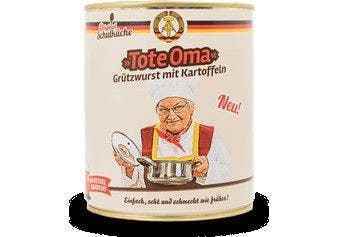The culinary offer in the GDR was characterized by shortages, but dishes from the SED dictatorship are in demand again. However, the fact that the largest German supermarkets sell “NVA soup” and canned goods decorated with hammer and compass does not make everyone happy.
Hammer, compass and FDJ scarf: The “Original School Kitchen Tomato Sauce” is advertised with symbols of the GDR dictatorship. Picture from the bunker museum in Rennsteighöhe.
In dictatorships, one hears again and again, not everything was bad. Hitler built the Autobahn. Under Mussolini the trains were on time. Stalin was an anti-fascist, Mao liberated the poor, and East Germany had good food. For example “Tote Oma”, with grützwurst and potatoes. Or Hoppel-Poppel, the legendary fried potato dish. Of course, the socialist dictatorship was not improved by these courts, and the GDR was just as backward in culinary terms due to the economy of shortages as in automobile construction: There was too much fat and not enough vitamins.
GDR symbols as a marketing gimmick
Nevertheless, East German cuisine is experiencing a revival. This is not only shown by books like “Eating like Erich. 27 GDR state menus to cook yourself” or newspaper articles about Hoppel-Poppel and Affenfett. Title: “It’s so quick to conjure up the spread from Honecker’s times!” West German capitalists, Honecker’s former class enemies, are also profiting from the culinary nostalgia. Major distributors such as Rewe, Kaufland, Globus and Edeka offer a whole range of canned goods, from “tomato sauce with hunting sausage” to “school kitchen solyanka” (with sausage and meat) to “dead grandma”, which is still on the can label looks boldly into the camera. Everything should taste “just like before”.
For military friends, Edeka also has an “NVA field soup”, prepared according to the original recipe of the National People’s Army, with pork belly and yellow corn. What is made palatable to customers with the slogan “Get a piece of GDR back on your plate” has now triggered a discussion about trivializing the dictatorship and the lack of a culture of remembrance. The Federal Foundation for the Reappraisal of the SED Dictatorship is not at all happy about the products. Not because you have anything against solyanka and hunting sausage. Rather, one is bothered by the fact that symbols of the SED dictatorship are used for marketing purposes by officially “responsible” corporations such as Rewe.


“It tastes like it used to be”: “School kitchens Soljanka” and “Tote Oma” from the shelves of German wholesalers.
The canned goods not only show the GDR state coat of arms with a hammer and compass. The children who advertise solyanka and sausage goulash on the labels with tablespoons and mouths smeared with orange wear red and blue scarves, which were the hallmarks of the communist pioneer organizations in the GDR. The NVA, on the other hand, was involved in building the Wall in 1961, and its soldiers shot at refugees at the border.
“If a soup tastes good, it sells without borrowing from a dictatorship that shot hundreds of people and imprisoned hundreds of thousands,” says Anna Kaminsky, director of the Federal Foundation for the Reappraisal of the SED Dictatorship. “Anyone who sells products presented in this way is playing down the GDR as a nice folklore baron. But she wasn’t.” Kaminsky intervened at Rewe to remind major German retailers of their social responsibility. There, however, one sees no reason to do without hammer, compass and field soup nostalgia.
In a statement to the Federal Foundation, which is available to the NZZ, Rewe writes that the products correspond to a “customer wish”. As far as the packaging is concerned, reference is made to the manufacturers, including a family company from Saxony-Anhalt. This produces the NVA soup, with the head of the house proudly pointing out that her husband was in the People’s Navy and the demand for the canned food was “huge”. The company, as can be seen on the website, has already been honored with a visit by the current Prime Minister Reiner Haseloff, funded by the EU and celebrated in the local press (“NVA field soup recaptures the stomachs”).

Cooked by a former member of the GDR People’s Navy: “NVA Field Soup” from Saxony-Anhalt.
The liberal and money-driven use of communist insignia and icons is not an East German phenomenon. A few years ago, a large Swiss furniture store sold plush Mao busts for the wall unit, and the Stalinist homophobe Che Guevara is still marketed as a red savior to this day. When Cuban exiles in Basel recently protested against a larger-than-life photo of Che in a left-wing bar, they were met with incomprehension: Che, according to the innkeeper, was a “hero who stood up for the Cuban people and wanted to free other peoples from oppression”. .
It is not the first time that the GDR canned goods from Rewe, Edeka and Co. have come under criticism. “Does that have to be?” asked the “Berliner Zeitung” back in 2014, with an Edeka head salesman indirectly answering “Yes”: The cans “arrived” with the buyers, and in addition in the GDR “not everything was bad been”. With reference to customer wishes and the good side of every dictatorship, you could of course expand the range as you wish – for example with a set of thin soup, a piece of bread, some margarine and a slice of liver sausage, plus a flashlight to blind yourself. Slogan: «Eating like Erich Mielke in Hohenschönhausen. Tastes like before.”
